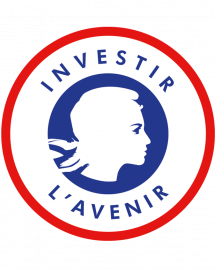Innovative pre-disposal projects: recycling, decontamination and testing
The "Investing for the future" funding enables Andra to support innovative initiatives to optimize, upstream of storage, the management of radioactive decommissioning waste. The project presented on this page are such projects related to Decontamination, recycling of radioactive waste, and destructive/non-destructive testing
 Endowed with nearly 47 billion euros, the Investissements d'Avenir program is an investment program of the French State, set up in 2010 to finance innovative and promising projects on the territory, with a principle of co-financing for each project.
Endowed with nearly 47 billion euros, the Investissements d'Avenir program is an investment program of the French State, set up in 2010 to finance innovative and promising projects on the territory, with a principle of co-financing for each project.
Andra benefits, under the "Nuclear of Tomorrow" part of this program, from an allocation of € 75 million to develop innovative radioactive waste management solutions, upstream of storage: characterization, treatment, conditioning of Radioactive waste. By participating in these projects, Andra ensures that the constraints and requirements of storage are taken into account at the earliest, from the very design of radioactive waste treatment or conditioning solutions.
RECYCLING PROJECTS
CYBER
Innovative recycling of VLLW concrete in radioactive environments
microwave oven for earth
processing
The CYBER project aims to develop an innovative process for treating rubble using microwave heating, in order to:
- selectively separate the components of concrete: coarse aggregates, sand and cement paste, • decontaminate the coarse aggregates and sand,
- define and qualify uses for the separated components: in France, reuse in the nuclear industry (e.g. as a material used in disposal facilities) and, for the international market, recycling outside the nuclear sector, given differences in regulations outside France.
Unlike the standard process which involves mechanically crushing concrete, CYBER aims to separate out the raw components without degrading their characteristics. Moreover, reuse of cement paste as a stabilisation agent will be explored.
To learm more on the project
ORCADE
Recycling electrical cables in waste from decommissioning nuclear sites
(to be adapted to the nuclear sector)
The ORCADE research project aims to develop two approaches to reduce the volume of VLLW electrical cables for disposal:
• Approach A, known as "stripping", will focus on developing deployable technology for recovering the metal wire in the cables and preventing any transfer of contamination from the sheathing, with a view to reclassifying it as conventional waste that can be cleared for recycling; • Approach B, developed as a backup method if approach A fails, entails adapting conventional industry solutions to the nuclear field, to separate, sort and reduce (by shredding) the volume of waste in order to separate the metal wire from the sheathing.
To learm more on the project
RTG
Radioisotopic Thermal Generator
In Cigéo, the system deployed to observe and monitor the disposal facility will require a power supply for the sensors installed 500 metres below ground, in the radioactive waste disposal cells. To this end, current research is focused on standalone systems rather than cabled systems, which would not only imply a high intrusion risk given the fact that the power cables would have to penetrate through the different barriers in the facility (disposal cells, seals and surrounding rock), but would also entail the risks associated with deterioration of the cables over time (e.g. power cuts).
A radioisotopic thermal generators (RTG) converts heat from radioisotope decay into electricity by the "Seebeck effect" The RTG project is an industrial research project whose main objective is to design and produce an inactive prototype (i.e. using a simulated radioactive source) for a standalone RTG powered by americium-241, a radionuclide never been used before as the heat source in an RTG.
To learm more on the project
DECONTAMINATION PROJECTS
CADET
Assisted cavitation for water decontamination
variation when they pass through
the liquid..
The aim of the CADET ((Assisted cavitation for water decontamination) project is to develop a process for decomposing organic compounds in effluents from nuclear plant decontamination. The cavitation used in this process is a phenomenon where gas bubbles form in a liquid by changing the pressure. When these "cavitation bubbles" implode, they create extreme pressure, temperature and turbulence conditions (localised creation of a non-equilibrium plasma) that initiate and accelerate chemical reactions around them, and thereby effectively break down the chemical agents used to trap the radioactive elements from cleaning operations.
To learm more on the project
NON-DESTRUCTIVE AND DESTRUCTIVE TESTING
DCND
Dynamic and Non-Destructive Testing
on a concrete container
The DCND project aims at developing a detailed diagnostics system for potential defects on concrete structures. It should lead to the ability to estimate the position, size and nature of any damage or cracks within concrete, in building and waste containers.
To learm more on the project
SCCoDRa
Monitoring and testing for corrosion in metal components used for radioactive waste disposal
integrity of the radioactive waste
containers
The design for the Industrial Centre for Geological Disposal (Cigeo) is currently based on the use of tried and tested materials, including metals (steels), which play a major role. Andra has therefore carried out studies on the corrosion of these metals for many years. Part of this research, SCCoDRa focuses on developing innovative tools for inspecting and monitoring steel corrosion over time
SCCoDRa is an industrial research project with two key objectives:
• to develop a nondestructive testing (NDT) technique (contactless) to inspect metal radioactive waste containers upon reception at the disposal facility (in the case of ILW-LL) to verify their integrity simply, quickly, reliably and precisely.
• to develop a methodology for monitoring corrosion in certain metal structures within the facility over time.

